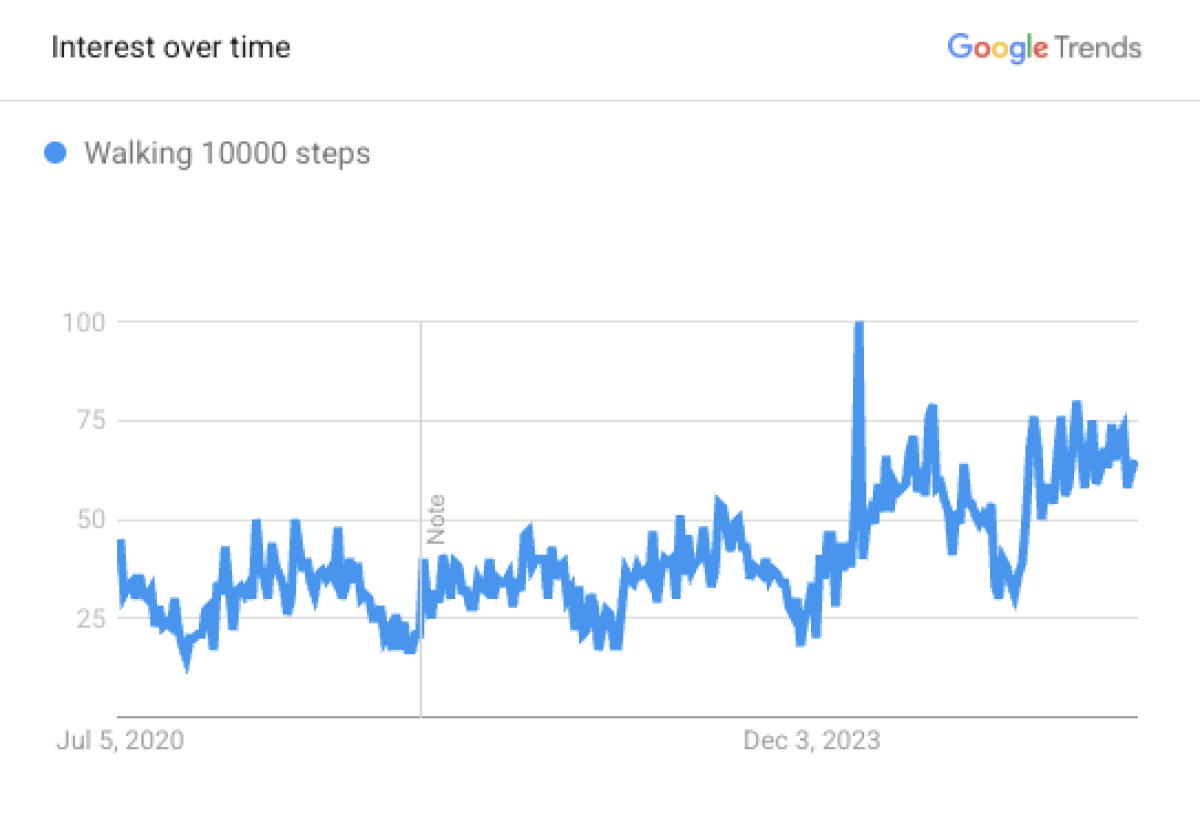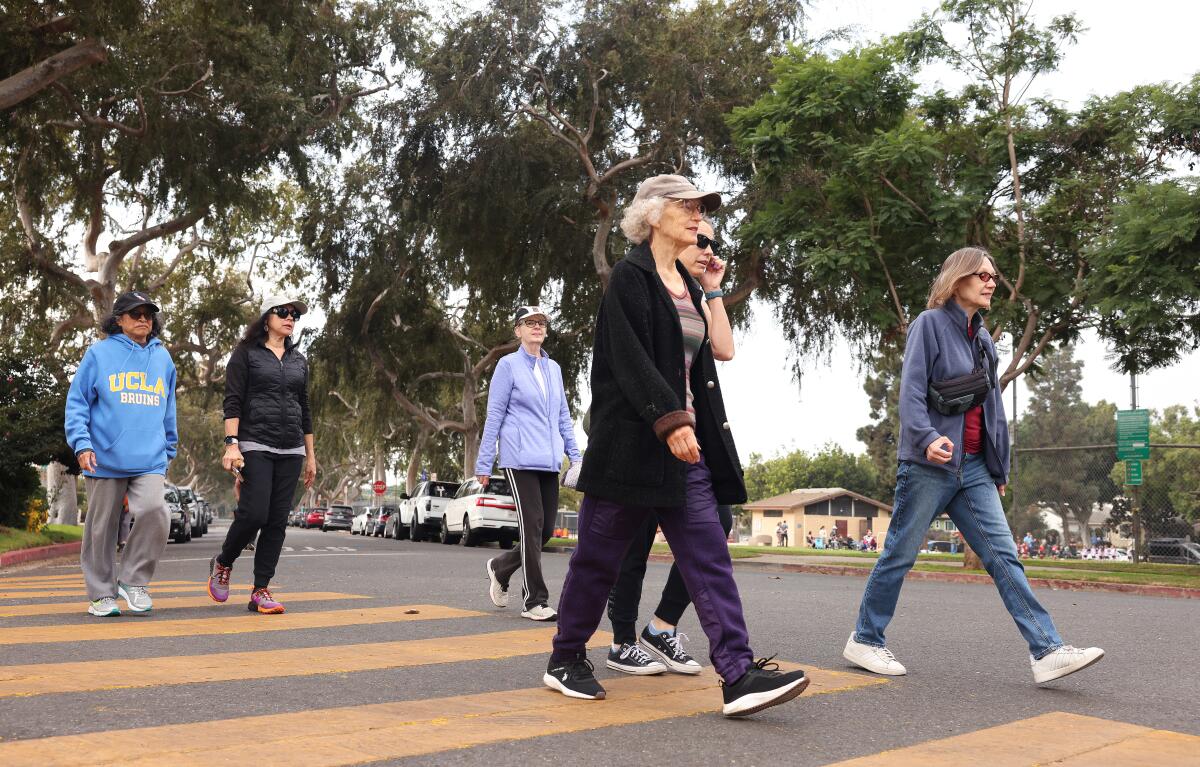Is walking 10,000 steps a legit fitness goal or a marketing myth?

- Share via
- The 10,000-step benchmark started as a marketing strategy for a 1960s Japanese pedometer, not a medical recommendation.
- Research now shows health gains can start with far fewer steps — as low as 2,500 per day.
- Local cardiologists say there’s no magic number: Just aim to move a little more than you did yesterday.
The magic number shows up on smartwatches, fitness apps and office step challenges. For many, hitting 10,000 steps in a day has become a marker of good health — a goal that prompts post-dinner walks, lunchtime laps around the block and a reason to park a little farther away.
While the target is widely embraced by doctors and their patients, its origins are less scientific than some may expect.
“The whole idea behind the 10,000 steps was actually a marketing campaign for a company in Japan that developed a pedometer,” said David Raichlen, professor of biological sciences and anthropology at USC.
The idea of walking 10,000 steps a day gained popularity in Japan in the 1960s, when a company introduced a pedometer called the Manpo-kei — a name that translates to “10,000 step meter.” Released around the time of the 1964 Tokyo Olympics, the product gave people a numerical goal and helped sell pedometers.
“It was kind of brilliant,” Raichlen said. “Is it arbitrary? Yes.”

Researchers say that even if the number wasn’t evidence-based at the time, it caught on for a reason — and may have landed close to a meaningful benchmark.
“It turns out, bizarrely enough, they probably weren’t that far off, even though they did not have any of the epidemiological data to support it at the time,” Raichlen said.
In the years since the 10,000 step target gained attraction, researchers have tried to pinpoint how many daily steps are actually linked to better health outcomes. Some studies show that benefits such as reduced risk of cardiovascular disease begin around 2,500 to 3,000 steps a day. Others suggest a plateau of health-related benefits begins around 7,500 steps, Raichlen said.
These exercise-based social clubs cater to every interest and skill level — from stairclimbing to slow walking — and almost all them are free.
Still, many public health messages continue to promote the five-digit mark, and fitness trackers, including Fitbits and other smart devices, often set 10,000 steps as the default daily goal.
Dr. Gregg C. Fonarow, interim chief of cardiology at UCLA, said step counts are a practical, easy-to-understand way to communicate physical activity guidelines with patients. He often recommends 10,000 steps and doesn’t view the number as random.
“Conveying step count is one of the ways of quantifying, easily and understandably, a trackable, actionable way to communicate what would be a good level of physical activity for them,” Fonarow said.

He said 10,000 steps equals roughly five miles of walking and about 150 minutes of moderate-to-intense activity — in line with existing guidelines for weekly exercise.
Still, Fonarow acknowledges that research findings vary. He cites one study that found risk reduction plateaued around 7,500 steps for older women, while other studies have found benefit continuing through 10,000 steps or more. “Walking is a fantastic form of exercise,” Fonarow said. “It improves blood pressure, supports brain health, reduces insulin resistance and helps strengthen the blood vessels.”
Raichlen said he typically avoids prescribing specific thresholds. While 10,000 steps may be a useful goal for some, he said, it is not a requirement for good health.
“A little bit is better than nothing, and then a little bit more is better than that,” Raichlen said.
However, the type of walking matters. Researchers have found that cadence — how many steps a person takes per minute — can influence the impact of physical activity. A brisk walk offers greater cardiovascular benefit than a slower pace even with the same total step count.

“You don’t have to run,” Raichlen said. “But more intensity is generally better.”
What’s not clear, he said, is whether there’s an upper limit where benefits begin to decline — or if more steps always yield more return.
He said walking more is generally tied to lower risk of several chronic conditions, including diabetes, dementia and cardiovascular disease, but the risk reduction plateaus after a certain point.
“The health outcome you are interested in — whether that be heart disease, diabetes, dementia — there are different steps recommended,” he added.
Want to explore L.A. foot but don’t know where to go? Here’s our complete collection of city walking guides
Raichlen also pointed out that the effectiveness of a given step count may differ by age and that most existing studies rely on wrist-worn accelerometers, which can vary in precision.
“You can use multiple methods and end up with multiple different step counts from the exact same person,” Raichlen said, adding that his sister-in-law and her son tracked their steps on a recent trip to Disneyland using different devices — one with a phone, the other with an Apple Watch — and came away with very different totals.
That variation, he said, reinforces the importance of using step counts as a guide rather than a rigid rule.
“The best thing people can do is to be their own study,” Raichlen said. “Look at what you’re doing today and try to do more tomorrow.”
Fonarow said he often encourages patients to build activity gradually. For those who are largely sedentary, trying to walk 10,000 steps on day one may not be practical. “We really need to personalize these recommendations,” he said, adding that some people may choose to add resistance — like a weighted backpack — for additional benefits, but it’s not necessary for improved health.

Dr. Parveen Garg of Keck Medicine of USC also sees patients aiming to meet step goals. While spreading activity throughout the week is ideal, he said it’s fine if some days are more active than others. For patients with limited time or energy, walking more on the weekends or during longer breaks can still offer meaningful benefits.
Garg said he reminds patients that walking is beneficial even at lower levels. Multiple studies show that risk of cardiovascular disease and premature death decreases measurably beginning around 2,500 steps per day, he said.
While spreading activity throughout the week is ideal, he said it’s fine if some days are more active than others. For patients with limited time or energy, walking more on the weekends or during longer breaks can still offer meaningful benefits. Like other experts, Garg emphasizes that the benefits of movement don’t begin at 10,000 steps — they can start much earlier.
Los Angeles County is filled with stair walks with striking ocean views. Here are some of our favorites.
“As humans, we like goals,” Garg said. “We like to feel like we’ve accomplished something. We like to check off boxes. … It does give people a goal to accomplish. In that aspect, it’s really great — as long as it does not discourage people.”
He encourages his patients to prioritize aerobic activity — movement that gets the heart rate up — even if it’s done in short bursts or mixed into daily routines.
Whether a person walks 2,000 steps or 10,000, local experts agree the key is consistency, and increasing activity over time can be beneficial.
“Just keep moving,” Raichlen said.
More to Read
Sign up for The Wild
We’ll help you find the best places to hike, bike and run, as well as the perfect silent spots for meditation and yoga.
You may occasionally receive promotional content from the Los Angeles Times.













